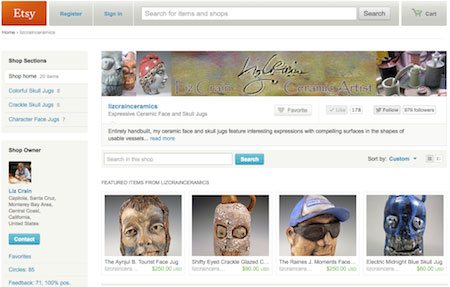Guest Blogger: Liz Crain
Let’s be plucky and candid about the costs of offering your art for sale online.
To plunge into the Web’s round-the-clock marketplace is both daunting and compelling. It’s delicious to imagine prodigious sales allowing you to “Quit Your Day Job” so you can ship hoards of orders in your Dr. Denton’s and then glide into your studio to make more.
Well, that is the sizzle promoted to us by online art marketplaces! And it could happen. Are you clear about what might be involved?
If you’ve looked into sites such as ArtFire, Artful Home, Etsy, Luulla, Ruby Lane, TrEmbu, eBay, you have a taste of the possibilities.

Regardless of your experience, my mission is to rip through the veils of illusion that obscure the real costs of online art selling and to make sure these costs are in line with your expectations.
TIME: How long does it take you?
No doubt about it, creating and managing your online shop will take chunks of time. How much depends on your learning curve, market sense and enjoyment.
Aside from making and offering your best art, online selling demands adept presentation. Your digital images and words need to serve in lieu of the real objects and require excellent photography, lively and accurate descriptions, market-savvy pricing, effective tags, and realistic shipping fees.
How long does it take you to create listings and manage them? How often do you “fluff and fold” to keep things current?
Do you tweet, pin, post and blog about your shop’s activities?
Do you spend time on the boards, blogs or teams? Do they require additional activities?
When you sell something, how much time does it take to correspond, package and ship? Follow up? Handle damages or returns?
Translate your hours into a dollar amount. After a reasonable learning curve, do your sales cover it?

Don’t forget, it’s time away from the studio, too.
After several years of my own Etsy tweaking and tilting at windmills, I can confidently tell you that what consistently sells are my ceramic face and skull jugs. More interestingly, they always sell East of the Mississippi to collectors I couldn’t meet any other way, since I’m in California. Nothing else I’ve listed, plain or sublime, has done well enough to justify the time involved. One guess what’s in my Etsy Shop!
TEMPERAMENT: Do you have the stomach for it?
Aside from Time, there’s affinity, a.k.a. Temperament. They go together. If you enjoy it, you’ll probably spend more time at it. More time likely means greater effectiveness leading to increased sales, which makes for even more affinity.
Do you enjoy shooting and editing your photos, writing snappy catalog-style copy, creating the best pricing, tagging, promotion, shipping and customer service?
Do you like experimenting, tweaking and checking Shop Stats?
Are you happy with online communities, customers and communication?
Are you able to maintain a separate inventory for your online venue?
If you’re cool with all of this, great!
But it’s not for all artists and there’s no problemo in skipping online selling in favor of other opportunities that hold more charm and meaning for you.
Since 2009, when I opened my Etsy Shop, I’ve run the gamut of personal wrangling, from overwhelmed and petulant to overjoyed and even smug. My temperament is such that I will keep poking at it until it behaves for me, but I don’t necessarily recommend my approach.
I had a lot of newbie fantasies to lose, too. A valuable side effect of my mistake-riddled persistence is I’ve learned to shoot great photos, write about my work colorfully yet realistically, define my niche and spend the least amount of time to be viable in it. Nothing can take that away and the skills are completely transferable!
MONEY: Ready for the accounting part?
Alyson offered a post entitled What is Your Art Business Costing You?, which helped us clarify the total cost of each venue. Online selling is not any different and deserves the same frank cost/benefits accounting.
Here’s a list of possible expenses:
- Site membership/Monthly fees
- Item listing/Relisting fees
- Ad and promotion fees
- Sales commissions
- Payment processing fees
- Team dues and fees
- Shipping materials
- Postage and insurance, if not paid by buyer
- Cost of damage and returns
- Cost of free swag tucked in with purchase
- A dollar figure reflecting the time you spent to create an active shop
It helps to understand the depth of the pool you’re plunging into. Research the online venues you’re interested in. Compare features and fees. Find reviews.
Etsy won’t say, but reasonable guesstimates suggest over 300,000 sellers, more than 13 million current listings, and over $3 million in sales each month. Did you do the math? That averages out to 23 cents per listing or $10 per seller.
EXPECTATIONS: What do you hope to gain?
What do you expect from entering the online art marketplace?
How much time are you willing to spend?
Does your temperament fit what would be required of running an online store?
Does the projected income make it worth your while?
If you don’t know the answers to these questions, research and experiment to discover them. The clear-eyed results will rip through any veils of illusion.
About Our Guest Blogger
Liz Crain has been selling her ceramic art on Etsy since 2009. She specializes in expressive character face and skull jugs.




28 thoughts on “Ripping Through the Veils of Illusion Around Online Art Marketplaces”
Sure it is up to each artist to decide on what works for them. From my personal experience a website has worked very well. I also have art in a gallery, but sell more online due to greater reach. If you go for it then make it count – get your own domain and website/blog. What better way to sell your lifestyle than through a website. Collectors love to know who you are.
Wise words, Malcolm. SO glad to hear that online sales work for you. Your website is very appealing and so is your work, so I can see why the direct online route works for you. How do you promote it?
After reading this piece, it’s easy to see why Liz is successful as an artist and a blogger. She takes us out of the clouds and brings us solidly to earth with clarity, charm and a clear road map to finding our version of success. Thanks Liz!
Hey Patty, thank you! Us clay folks never are far away from the well-grounded earth, I spose.
I’ve been selling on Etsy since April 2010 and highly recommend it.
The exposure to customers around the world, interior designers, magazines, blogs, galleries, licensing, ect is incredible. You’d be surprised who’s looking at Etsy.
I’ve combined it with selling in galleries and at shows and made a nice business.
There is a lot of work involved, but there is with any business if you want to succeed and it’s fun work.
Linda, you just said it all in a nutshell! Thanks.
Great article – I would add that in addition to taking on all of the above, you also have to be ready to face the *constant change* of online selling. Sure, change is inevitable, but on the frontier of web sales change is relentless, swift, and not always predictable. If you are resistant to the technology and just catch up enough to get by, it can be exhausting to feel the sand constantly shift under your feet. And all that change does end up being a cost if it eats into your making time.
I guess I’m lucky to be a consummate tweaker – I enjoy it. I’ve been on Etsy since 2005 but am looking forward to returning to my own website (again). Even though I know how much work is involved, ultimately having more control over my customers’ experience wins for me.
Hi Helen,
You’re making an important point here: Every time Etsy changes something their forums light up with both jubilation and hand-wringing! (I bet we’ve done both, too!) I guess staying agile in the face of shifting technology would be a part of having the temperament for it. I know it certainly was an important adjustment for me!
And it’s interesting that you, as an Etsy “early adopter,” are now taking the reins for yourself.
Interesting blog but it has the monthly sale numbers way off. For the month of May, 2012 sales to sellers on Etsy were 65.9 million dollars (not 3 million as stated) up 65% from last May, 2011. Also, what was not detailed are what the fees for selling on Etsy are, no monthly fee, 20 cents and item to list, Etsy’s transaction fees are only 3.5% and Paypal fees are 2.7% for a total of only 6.2%. IMO, this is a super low fee to have access to a world wide market. Etsy’s website is ranked 174 in the world and 58 in the US. This means there are only 57 website in the US that get more traffic. I think people should do their own research into the many profitable online venues and not rely on this author’s opinion, much of what she says is overstated.
Are you an artist, or a sales person? You sound like you’re writing with a lot of experience in online sales. This article does a great job outlining all the things to consider for those who haven’t yet ventured into it the online marketplace. What were the lessons you had to learn when you first started selling online?
Hi Regor, Yes I am am artist. Ceramics and Printmaking. I first started selling on Ebay in 1997. I was one of the first Potters to sell there and the first one to be selling tea ware, Chawan and Yunomi. I had over 3000 sales before I quit. Ebay got to buyer friendly and not real supportive of sellers and their fees when through the roof. My point in responding, in the way I did, is exactly to your statement that this blog does a great job outlining what it take to sell online. If one was to take Liz’s experience for more than just her experience they would likely not venture into the great opportunities that online selling can offer. To all of Liz’s points there are positive counter points that if stated would led one to start online immediately. I’m a very practical guy, I don’t want to work harder than I have to on anything, and selling online through venues like Etsy have allowed me to work smarter and not harder.
The biggest lesson was to learn that I am running a business and like any other business my online business needed to be managed. Putting your stuff out there and waiting for the world to come to you is not enough. You have to be present and open for business everyday.
Hi Michael,
Thanks for your insights and numbers. I agree with you completely that folks should not rely on my opinion, but think it through and do the research for themselves.
Fees and costs vary site to site and conclusions about their acceptability and value-in-tradeoff, along with the other factors of time and temperament, rightfully belong to each one of us.
Hi Liz, I often hear about how much time all this online stuff takes…I ask, compared to what? When sales are made online I retain 93%+ of retail. If I sell through a gallery I may get as little as 50%. This fact along should motivate just about anyone of any temperament that’s serious about making sales as an artist. I’ve be making and selling art for over 40 years, I remember the costs of doing business the old fashioned way and the limited market reach at that time. IMO, as artists, we have never had it so good and at very little cost. This year alone I’ve made sale in Japan, Taiwan, Sweden, Norway, France, Australia, Canada, Slovenia and Russia. This would not have been possible in the past or now from my studio here in Colorado without the internet. I just would encourage everyone to give venues like Etsy a chance and to stick with it long enough to formula an experienced opinion.
Michael, I couldn’t agree with you more. Some of us live in locales that have a limited art scene and Etsy helps us find our customers. I should add that whether it be in a gallery or online, the relationships built within a community are essential to either venue working. If it were not for bloggers talking about my work and people pinning my work on Pinterest I would have had greatly reduced sales.
I do exhibit locally but its slow going and I have not sold a single painting locally vs. 49 in the in past 8 months on Etsy.
Liz nails it again. It’s really tough to make a profit (real income after MANY ignored expenses) online. I would add that Etsy OR any online venue requires *driving traffic* to your page(s) and or site(s) and that is not truly addressed in the costs.
Yes… I see the replies with the success stories – including Liz’s eventually profitable ITEM. But how much “time” was spent getting to this ITEM?: “After several years of my own Etsy tweaking and tilting at windmills, I can confidently tell you that what consistently sells are my ceramic face and skull jugs.” (Thanks for your candor, Liz! You rock.) If the years (and hours) were costed out throughout all sales to date… is it possible that she still has not actually made a profit on Etsy yet? (smile/wink)
Thankfully, we all have “losses” and understand that what we are learning in the process is just a cost of doing business and we hope those lessons will create our successful ITEM eventually. R & D… we all go through it, we just need to understand that some R & D won’t ever bring a return. The price points really really matter here.
Her price tag is very important to note. Many of the people reading this will be in the over $200 price range and that is key. All the time it takes to photograph, then tweak, then upload, then tag and describe and KEEP THAT item available (tying up that inventory item) for sale and shipment (it can’t be something similar!) and dealing with correspondance or calls from potential collectors is not profitable for a $50 item. Let alone all the people I see that are selling “crafty” things for $15.00. Just putting that item in a box and addressing the label takes all the profit out!
That valuable time spent on getting a single item to the retail marketing channel must have good ROI (return on investment – and time is money!) and that means having that time spent on an item of higher value. Otherwise – keep the day job!
Thanks for bringing this issue to your devoted fans, Alyson. It’s so important that this veil be lifted.
OOooh, Mckenna, do you ever say it all!
These are the intangibles that are SO hard to define. Hours and hours spent, R & D and agile marketing, the failure/re-tooling cycle….peppered with just enough sales to help learn.
I’m sort of glad I didn’t keep track of anything more than my Big Goal for a long time. But now, well, I want it to earn its keep, or off I go!
Once we wake up to the whole picture, we hopefully make better choices and then better profits as a result! Thanks for your comments!
My thinking is be as self reliant & make it as user friendly as possible. If you depend on a 3rd party site to host your work, what will hapen if they crash. Can your public displays and your ETSY/facebook/google+/twitter/Pinterest posts also be used as a marketing tool to direct people directly to your website? Best bet…Have your own website with your own domain name and market that too everytime you market a peice of work ANYWHERE else. Just my $.02.
Hi Laura
I appreciate your 2 cents! You’ve hit upon the excellent practice of thinking bigger and beyond the particular venue you’re tango-ing with, always turning the focus back to you and your art. Thank you for chiming in.
hi liz,
another great post… here’s a link to an etsy marketing blog with traffic stats. not sure how accurate but somewhere in here i read that they estimate 875,000 users. http://www.handmadespark.com/blog/etsy-growth-check-out-these-4-charts/
Thanks for the link, Jim!
Wow am I glad I used the word “guesstimate” because in my research for this post I saw many other numbers. I chose the more conservative ones from Handmadeology. Just my choice.
It’s important, too, to note whether the numbers refer to Users, Sellers, Active Shops or ???. My number was Sellers, yours is Users. You’ve helped this be that much clearer, so thank you.
The post was not necessarily about definitive Etsy – it’s just where my learning experiences lay – the Big Mind takeaway is to be aware of a pantheon of considerations and expenses that may not be obvious to a newbie and, armed with that awareness, to research the scope and mechanics of the marketplace one is considering entering, and draw conclusions for oneself.
We can appreciate how much of a moving target this might prove to be. It’s very good to have the experiences, links, opinions and knowledge of others and then make our own call. Thanks again!
Liz,
I really enjoyed your article and gleaned yet more information as well as an objective opinion regarding Etsy! I am an Etsy artist/seller as well. I have been at it for just about a year. The way I look at it, it is yet another medium to get my art out into the world and seen by those who would not be exposed to it through gallery or art show sales. Yes, it does take some time and attention, especially at first, but really marketing yourself to galleries, entering shows, competitions or weekend art shows take similar time, expense, attention and preparation as well. As long as I prioritize my time and allow myself time to create, I find it gratifying, challenging and creative too! I will continue tweaking and re-vamping my Etsy shop as well as finding other successful means to market my work. Thanks so much for your input!
Shelly,
I enjoy your balanced view of how Etsy fits in to the rest of your creative world and the marketing of it. I especially appreciate you saying “as long as I prioritize my time and allow myself time to create…” because it’s so key.
Great article, Liz. I like the open eyes approach to making decisions about where to spend our time, attention and money.
Thanks for being so transparent about your experiences. It really helps understand the options on a deeper level.
Hi Cynthia, I’m jazzed you enjoyed this post!
Pingback: Monday Marketing – Online Business
Let alone all the people I see that are selling “crafty” things for $15.00. Just putting that item in a box and addressing the label takes all the profit out!>>>
not necessarily true. My biggest seller is sterling silver toe rings & ear cuffs. In July I sold $1500 worth of $10 cuffs/toe rings in my etsy store. I can make at least 100 toe rings in about an hour. So even if you want to cut it in half to cover my supplies, time marketing, photos, listing …it is quite profitable for me.
Of course, I don’t just make toe rings but when you price properly, do your labour effectively (it costs me more to make one toe ring at a time then it does to spend an afternoon knocking out a few hundred), purchase supplies in bulk (my last precious metal order a couple weeks ago was $1800), you can make a comfortable income with lower priced items.
I am finding Im getting a lot of repeat buyers for the rings plus repeat buyers who are back for more involved pieces.
Pingback: Year-End Review — Art Biz Blog
Pingback: Do The Math for the Juried Art Exhibit — Art Biz Blog